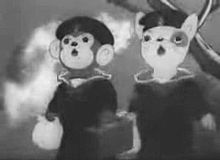- Momotarō: Umi no Shinpei
-
Momotarō: Umi no Shinpei Directed by Mitsuyo Seo Written by Mitsuyo Seo Music by Yuji Koseki Cinematography Mitsuyo Seo[1] Release date(s) April 12, 1945 Running time 74 min Country Japan Language Japanese Momotarō: Umi no Shinpei (桃太郎 海の神兵, lit. Momotaro's Gods-Blessed Sea Warriors or Momotaro, Sacred Sailors[2]) is the first Japanese feature-length animated film.[3] It was directed by Mitsuyo Seo, who was ordered to make a propaganda film for the war by the Japanese Naval Ministry. Shochiku Moving Picture Laboratory shot the 74-minute film in 1944 and screened it on April 12, 1945. It is a sequel to Momotarō no Umiwashi, a 37-minute film released in 1943 by the same director. It is black and white.[4]
Contents
Plot
After completing naval training, a bear cub, a monkey, a pheasant, and a puppy say goodbye to their families.[5] Like the prior film, the movie features the "Peach Boy" character of Japanese folklore. The film is about the surprise maneuver on Sulawesi island, depicting parachute troops' actions. The monkey, puppy and bear cub are the ones that become parachute jumpers while the pheasant becomes a pilot. [6] The whole movie also depicts the Japanese "liberation of Asia", as proclaimed by the Government at the time.
There are some musical scenes. Of note is The Song of AIUEO (アイウエオの歌 AIUEO no Uta), a scene where Japanese soldiers teach local animals how to speak.
Background
The Naval Ministry previously showed Seo Fantasia, a 1940 Disney film. Inspired by this, Seo tried to give dreams to children, as well as to instill the hope for peace, just as he did in the prequel movie, Momotaro's Sea Eagles.
The Song of AIUEO (アイウエオの歌 AIUEO no Uta) is famous for being given a homage in the series Kimba the White Lion (ジャングル大帝 Janguru Taitei) by Osamu Tezuka (Tezuka watched the film in April 1945. He later said that he was moved to tears by the movie's hints of dreams and hopes, hidden under the appearance of war propaganda).
For a long time, the film was presumed to have been confiscated and burnt by the American occupation. However, a negative copy of the film was found in Shochiku's Ofuna warehouse in 1983 and was re released in 1984.[7] A reproduced movie was later screened and the VHS package is now available in Japan.
Credits
- Production: Shochiku Moving Picture Laboratory (松竹動画研究所 Shōchiku Dōga Kenkyūjo)
- Auspices: Naval Ministry of Japan
- Movie organization: Kiichiro Kumaki (熊木喜一郎 Kumaki Kiichirō)
- Script, Choreography, and Direction: Mitsuyo Seo (瀬尾光世 Seo Mitsuyo)
- Shadow play: Kenzo Masaoka (政岡憲三 Masaoka Kenzō)
- Musical direction: Yuji Koseki (古関裕而 Koseki Yūji)
- Lyrics: Hachiro Sato (サトウハチロー Satō Hachrō)
References
- ^ http://www.imdb.com/title/tt0142666/fullcredits
- ^ "Momotaro, Sacred Sailors". Shochiku. http://www.shochikufilms.com/film/detail.php?product_code=358. Retrieved 2009-10-03.
- ^ Jonathan Clements, Helen McCarthy. The Anime Encyclopedia: A Guide to Japanese Animation Since 1917. Revised and Expanded Edition. — Berkeley, CA: Stone Bridge Press, 2006. — P. 12. — ISBN 978-1933330105
- ^ http://www.imdb.com/title/tt0142666/
- ^ Clements, Jonathan; McCarthy, Helen (2006) (in English). The Anime Encyclopedia. California: Stone Bridge Press. ISBN 1-933330-10-4.
- ^ Clements, Jonathan; McCarthy, Helen (2006) (in English). The Anime Encyclopedia. California: Stone Bridge Press. ISBN 1-933330-10-4.
- ^ Clements, Jonathan; McCarthy, Helen (2006) (in English). The Anime Encyclopedia. California: Stone Bridge Press. ISBN 1-933330-10-4.
- Patten, Fred (2004) [First published in Animation World Magazine 1, no. 7, October 1996]. "Momotaro's Gods-Blessed Sea Warriors: Japan's Unknown Wartime Feature". Watching Anime, Reading Manga: 25 Years of Essays and Reviews. Berkeley, CA: Stone Bridge Press. pp. 325–328. ISBN 1880656922.
- Clements, Jonathan and Helen McCarthy (2001). The Anime Encyclopedia : A Guide to Japanese Animation Since 1917. Berkeley, CA: Stone Bridge Press. ISBN 1-880656-64-7.
External links
Categories:- 1945 films
- Japanese films
- Anime and manga stubs
- Animated film stubs
- Japanese World War II propaganda films
- Animated films
- Anime of the 1940s
Wikimedia Foundation. 2010.

